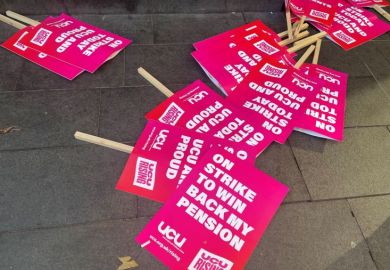Low-paid university staff in England could be made worse off by a new system for highlighting pay inequality, a vice-chancellor has warned.
In the first-ever report on senior staff remuneration released earlier this month, the Office for Students published ratios for each university showing how the head of a provider’s overall pay compared with the salaries of all other staff.
Pay ratios ranged from 3 to 13.4 when the salaries of vice-chancellors and median university pay were compared, the regulator’s report noted on 12 February.
However, David Green, vice-chancellor of the University of Worcester, told Times Higher Education that the new tool for calling out high pay may have adverse “unintended consequences” for thousands of lower-paid staff within universities.
Instead of reducing senior pay levels, some universities may seek to achieve a “better” median pay level by removing low-paid staff from their direct payroll, Professor Green predicted.
“If this ‘median ratio’ is persevered with it will probably start to incentivise university executive leaderships and boards to think differently about how they employ students to work in part-time roles at their university, if at all,” he explained.
“It will also provide a reputational incentive to outsource jobs in such areas as cleaning, security, grounds and lower-paid roles generally,” he said, adding that it may also deter universities from creating junior entry-level academic positions.
In the latest OfS report, Worcester, which paid Professor Green £325,000 in 2017-18, was named as having the second-highest vice-chancellor to average pay ratio of any institution in England, behind only Royal Holloway, University of London.
But its ratio of 13 would reduce to 8.6 if it did not directly employ almost 700 students, while its decision to keep cleaning, grounds and security staff in-house also impacted on its ratio, said Professor Green.
If the new ratio reporting led to more outsourcing it would undermine universities that sought to create “properly pensionable employment for many local people”, said Professor Green, who added that “directly employing our own staff…leads to a better experience for students as staff are more invested in the university and in students’ success”.
Nicola Dandridge, the OfS’ chief executive, said that the latest data report “further increased transparency…meaning that students, staff and the general public can understand much more about senior pay at universities and other higher education providers”.
“As we set out in our analysis report, there were some differences in the way providers calculated their pay ratios, with some including agency and contract staff while others did not,” she said.
Professor Green suggested that the OfS should instead publish ratios that compared vice-chancellors’ pay to three levels: the lowest point on academia’s 51-point pay spine, which would be £18,754, including pension contributions; the highest point (£70,366, including pension contributions); and top of scale 6, currently about £34,710.
This approach would provide “readily understandable general comparators to real jobs” and “give no incentive to outsource”, but would help to improve the salaries of the lowest-paid and entry-level salaries for new academics, said Professor Green.
Register to continue
Why register?
- Registration is free and only takes a moment
- Once registered, you can read 3 articles a month
- Sign up for our newsletter
Subscribe
Or subscribe for unlimited access to:
- Unlimited access to news, views, insights & reviews
- Digital editions
- Digital access to THE’s university and college rankings analysis
Already registered or a current subscriber? Login







